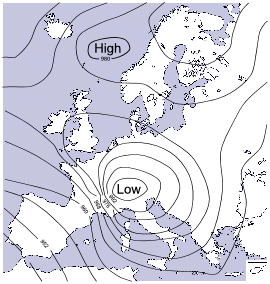
Atmospheric Pressure
This is the weight of the air as it presses on the Earth's surface.
Pressure varies from place to place and day to day because the Earth's surface is not heated evenly. Water and land have different heat capacities so the pressure of the atmosphere pressing down varies as well.
When air becomes warmer you will get an area of low pressure. Air molecules expand, it is less dense so it rises. As the air becomes colder the molecules contract and you have an area of high pressure. Wind is the movement of air between the two areas of pressure as it tries to balnce them.
Pressure is measured with a barometer and recorded in millibars (mb) or hectopascals (hPa). To make it easier to compare figures from different places, adjustments have to be made locally to allow for the height above mean sea-level (air pressure varies with height by about 1mb every 10 metres). Areas of the same pressure are connected together on a map by isobars.

